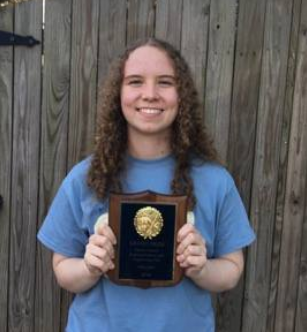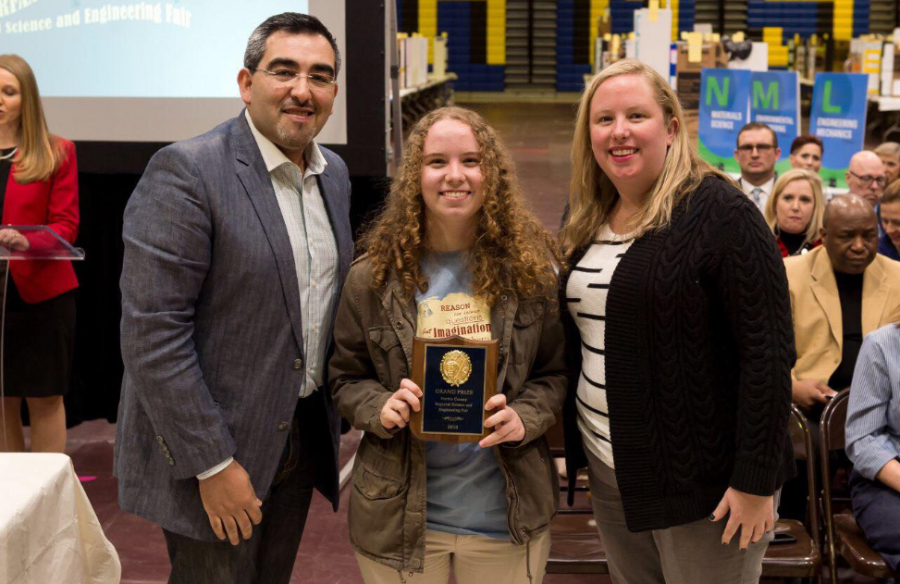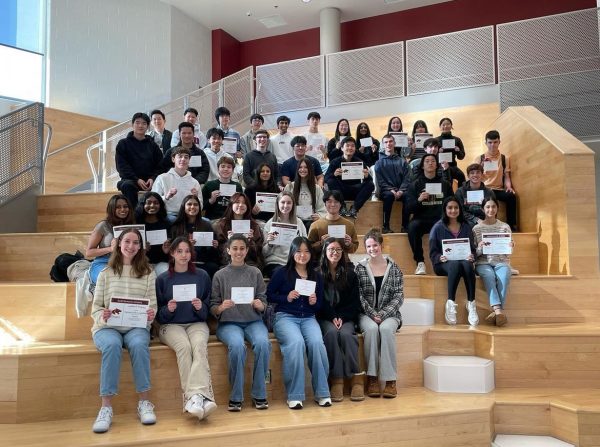Onto states and national competitions for Oakton scientists
After the Regional Science Fair, multiple Oakton students have the opportunity to share their research at future competitions.
Spending weekends on research, reading through published papers, designing and redesigning experiments. There is no rest for the weary, until after the Regional Science Fair.
Students from Oakton received various awards at the FCPS Regional Science Fair. In order to participate, students had to present their projects for judges. With various different categories that students could enter their research into, most projects fit into a category, if it was from animal science to physics & astronomy to systems software.
Shannen Prindle, 12, was selected as a Grand Prize Winner for her research in Translational Medical Sciences, A Novel Approach to Improving Photodynamic Therapy.
Prindle has been participating in the Regional Science Fair since freshman year, where she first got involved with bioluminescent algae. Since then, she has been continuing her research on the relationship between oxygen and the bioluminescence (CHECK) of cells. Sophomore year, Prindle’s focus was on bioluminescent applications, such as bioluminescent PTD. After her research with limited resources sophomore year, going into junior year, “I sent out a whole bunch of emails, which was a weird request because you usually do research through internships, but I was asking people if I could work on my idea, and I ended up in a lab at Johns Hopkins for five days,” said Prindle. The following summer, Prindle had the opportunity to conduct her research at Georgetown for a month in August.

Most people are surprised to know that even though I had inconclusive results junior year, and it was a very homemade experiment sophomore year, it didn’t really effect the judging.
— Shannen Prindle
This year, her project was specifically on photodynamic therapy. The idea behind this is that it uses light activated drugs, which are noninvasive and targeted. The main issue currently is that the external light source (usually a laser) doesn’t penetrate that deep into the skin, and tumors can have hypoxic regions (where there is little to no oxygen) and the photosensitive regions require oxygen to kill any cancer cells. Prindle’s technique combines bioluminescent light (the same light source in fireflies, where the light is inside the cell), and increased oxygen delivery in the patients to increase the photosensitive reaction. “And when you put those two things together, you get an even more effective, novel technique,” Prindle said.
Through the science fair, Prindle has learned how to deal with failure and working to get the answer. “I’ve been able to appreciate the depth of science, as well as the problem solving that goes into in,” Prindle said. Additionally, she has had the opportunity to talk with judges who are very knowledgeable in the fields she is interested in. Moving forward, since Prindle was a Grand Prize Winner, she will be moving onto ISEF for the third time. Additionally, she hopes to continue with this research as an undergraduate.
Harin Ok, 11, worked with Wen Ip,11, on a project in Earth & Environmental Science, Using Various Eluting Agents for Optimization of Biosorbent Filtration. Their project was a continuation of the research they had performed last year, where they tested biosorbents’ (biological agents that can filter heavy metals from water) ability to filter heavy metals from drinking water. To learn more about the biosorbent filtration method, they Ok and Ip used orange peels to test their ability to filter our copper sulfate from contaminated water, with the larger goal of determining how to use better filtration systems in developing countries. In the future, they are planning to research which biosorbents work best for which type of heavy metals. When asked what she enjoyed most about participating in the science fair, Ok responded, “talking to the judges, because some of them are very knowledgeable about the topic you are interested in, and they give a lot of feedback and suggestions.” Moving forward, since Ok and Ip were selected as grand prize nominees, they will be competing in the Virginia State Science and Engineering Fair.
While everyone might not be quite as passionate about science and research as the scientists at Oakton who participated in the Regional Science Fair, those who did participate deserve a shout out. After all, we can’t all claim to devote that much time to research and investigations just to learn.




